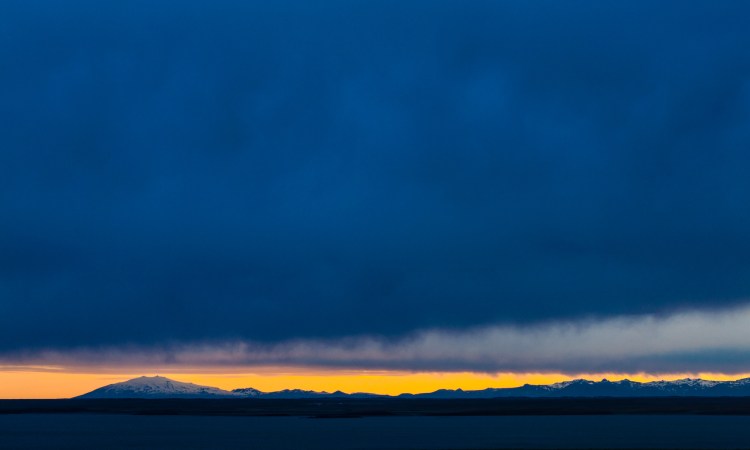
As technology accelerates our lives, many of us feel an urgent need to slow down. One seductive solution: A secular sabbath. Pico Iyer makes the case, in this meditative excerpt from his new TED Book, The Art of Stillness: Adventures in Going Nowhere
The idea of going nowhere is as universal as the law of gravity; that’s why wise souls from every tradition have spoken of it. “All the unhappiness of men,” the seventeenth-century French mathematician and philosopher Blaise Pascal famously noted, “arises from one simple fact: that they cannot sit quietly in their chamber.” After Admiral Richard E. Byrd spent nearly five months alone in a shack in the Antarctic, in temperatures that sank to 70 degrees below zero, he emerged convinced that “Half the confusion in the world comes from not knowing how little we need.” Or, as they sometimes say around Kyoto, “Don’t just do something. Sit there.”
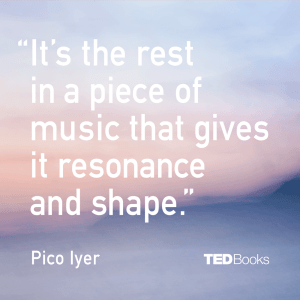 Yet the days of Pascal and even Admiral Byrd seem positively tranquil by today’s standards. The amount of data humanity will collect while you’re reading The Art of Stillness is five times greater than the amount that exists in the entire Library of Congress. Anyone reading it will take in as much information today as Shakespeare took in over a lifetime. Researchers in the new field of interruption science have found that it takes an average of twenty-five minutes to recover from a phone call. Yet such interruptions come every eleven minutes — which means we’re never caught up with our lives.
Yet the days of Pascal and even Admiral Byrd seem positively tranquil by today’s standards. The amount of data humanity will collect while you’re reading The Art of Stillness is five times greater than the amount that exists in the entire Library of Congress. Anyone reading it will take in as much information today as Shakespeare took in over a lifetime. Researchers in the new field of interruption science have found that it takes an average of twenty-five minutes to recover from a phone call. Yet such interruptions come every eleven minutes — which means we’re never caught up with our lives.
And the more facts come streaming in on us, the less time we have to process any one of them. The one thing technology doesn’t provide us with is a sense of how to make the best use of technology. Put another way, the ability to gather information, which used to be so crucial, is now far less important than the ability to sift through it.
It’s easy to feel as if we’re standing two inches away from a huge canvas that’s noisy and crowded and changing with every microsecond. It’s only by stepping farther back and standing still that we can begin to see what that canvas (which is our life) really means, and to take in the larger picture.
One day I visited Google’s headquarters to give a talk on the Dalai Lama book I’d completed and, like most visitors, was much impressed by the trampolines, the indoor tree houses, and the workers at the time enjoying a fifth of their working hours free, letting their minds wander off leash to where inspiration might be hiding.As I travel the world, one of the greatest surprises I have encountered has been that the people who seem wisest about the necessity of placing limits on the newest technologies are, often, precisely the ones who helped develop those technologies, which have bulldozed over so many of the limits of old. The very people, in short, who have worked to speed up the world are the same ones most sensitive to the virtue of slowing down.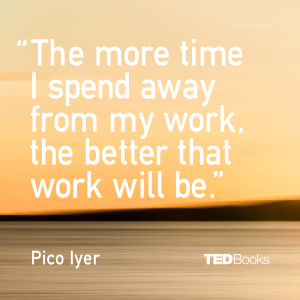 But what impressed me even more were the two people who greeted me as I waited for my digital ID: the Chief Evangelist for Google+, as his business card would have it, a bright-eyed, visibly spirited young soul from India who was setting up a “Yogler” program whereby the many Googlers who practice yoga could actually be trained to teach it; and the seasoned software engineer beside him who ran a celebrated and popular seven-week program called “Search Inside Yourself,” whose curriculum had shown more than a thousand Googlers the quantifiable, scientific evidence that meditation could lead not just to clearer thinking and better health but to emotional intelligence.
But what impressed me even more were the two people who greeted me as I waited for my digital ID: the Chief Evangelist for Google+, as his business card would have it, a bright-eyed, visibly spirited young soul from India who was setting up a “Yogler” program whereby the many Googlers who practice yoga could actually be trained to teach it; and the seasoned software engineer beside him who ran a celebrated and popular seven-week program called “Search Inside Yourself,” whose curriculum had shown more than a thousand Googlers the quantifiable, scientific evidence that meditation could lead not just to clearer thinking and better health but to emotional intelligence.
A self-selecting pair, no doubt; these were the kind of guys who wanted to hear about the Dalai Lama. Every company has its own chief evangelists, eager to share their illuminations. But I was struck by how often Gopi, the founder of the Yogler program, spoke of how easy it was, day or night, to go into a conference room and close his eyes. It sounded a bit like Dickinson again:
The Outer—from the Inner
Derives its Magnitude—
’Tis Duke, or Dwarf, according
As is the Central Mood.
Many in Silicon Valley observe an “Internet Sabbath” every week, during which they turn off most of their devices from, say, Friday night to Monday morning, if only to regather the sense of proportion and direction they’ll need for when they go back online. I was reminded of this by Kevin Kelly (TED Talk: How technology evolves). Kelly, one of the most passionate spokesmen for new technologies (and the founding executive editor of Wired magazine), had written his latest book about how technology can “expand our individual potential” while living without a smartphone, a laptop, or a TV in his home. Kevin still takes off on months-long trips through Asian villages without a computer, so as to be rooted in the nonvirtual world. “I continue to keep the cornucopia of technology at arm’s length,” he writes, “so that I can more easily remember who I am.”
There is now a meditation room in every building on the General Mills campus in Minneapolis, and Congressman Tim Ryan leads his colleagues in the House of Representatives in sessions of sitting still, reminding them that, if nothing else, it’s been found by scientists that meditation can lower blood pressure, help boost our immune system, and even change the architecture of our brains. This has no more to do with religion or any other kind of doctrine than a trip to the (mental) health club might.
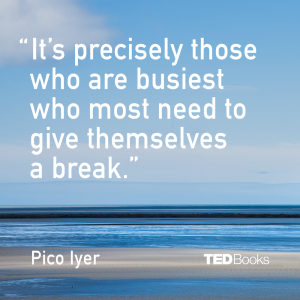 Indeed, fully a third of American companies now have “stress-reduction programs,” and the number is increasing by the day — in part because workers find unclogging their minds’ arteries to be so exhilarating. More than 30 percent of those enrolled in such a program at Aetna, the giant heath-care company, saw their levels of stress dropping by a third after only an hour of yoga each week. The computer chip maker Intel experimented with a “Quiet Period” of four hours every Tuesday, during which three hundred engineers and managers were asked to turn off their e-mail and phones and put up “Do Not Disturb” signs on their office doors in order to make space for “thinking time.” The response proved so enthusiastic that the company inaugurated an eight-week program to encourage clearer thinking. At General Mills, 80 percent of senior executives reported a positive change in their ability to make decisions, and 89 percent said that they had become better listeners, after a similar seven-week program. Such developments are saving American corporations three hundred billion dollars a year; more important, they’re a form of preemptive medicine at a time when the World Health Organization has been widely quoted as stating that “stress will be the health epidemic of the twenty-first century.”
Indeed, fully a third of American companies now have “stress-reduction programs,” and the number is increasing by the day — in part because workers find unclogging their minds’ arteries to be so exhilarating. More than 30 percent of those enrolled in such a program at Aetna, the giant heath-care company, saw their levels of stress dropping by a third after only an hour of yoga each week. The computer chip maker Intel experimented with a “Quiet Period” of four hours every Tuesday, during which three hundred engineers and managers were asked to turn off their e-mail and phones and put up “Do Not Disturb” signs on their office doors in order to make space for “thinking time.” The response proved so enthusiastic that the company inaugurated an eight-week program to encourage clearer thinking. At General Mills, 80 percent of senior executives reported a positive change in their ability to make decisions, and 89 percent said that they had become better listeners, after a similar seven-week program. Such developments are saving American corporations three hundred billion dollars a year; more important, they’re a form of preemptive medicine at a time when the World Health Organization has been widely quoted as stating that “stress will be the health epidemic of the twenty-first century.”
It can be strange to see mind training — going nowhere, in effect — being brought to such forward-pushing worlds; the businesses that view retreats as the best way to advance may simply be deploying new and imaginative means to the same unelevated ends. To me, the point of sitting still is that it helps you see through the very idea of pushing forward; indeed, it strips you of yourself, as of a coat of armor, by leading you into a place where you’re defined by something larger. If it does have benefits, they lie within some invisible account with a high interest rate but very long-term yields, to be drawn upon at that moment, surely inevitable, when a doctor walks into your room, shaking his head, or another car veers in front of yours, and all you have to draw upon is what you’ve collected in your deeper moments. But there’s no questioning the need for clarity and focus, especially when the stakes are highest.
The need for an empty space, a pause, is something we have all felt in our bones; it’s the rest in a piece of music that gives it resonance and shape. That’s the reason American football players prefer to go into a huddle rather than just race toward the line of scrimmage, the reason a certain kind of writer will include a lot of blank space on a page, so his sentences have room to breathe (and his readers, too). The one word for which the adjective “holy” is used in the Ten Commandments is Sabbath.
In the book of Numbers, God actually condemns to death a man found collecting wood on the Sabbath. The book on the Sabbath is the longest one in the Torah, as Judith Shulevitz explains in her fine work, The Sabbath World. Another part of the Torah, dealing with the Sabbath’s boundaries, takes up 105 pages more.
Keeping the Sabbath — doing nothing for a while — is one of the hardest things in life for me; I’d much rather give up meat or wine or sex than the ability to check my emails or get on with my work when I want to. If I don’t answer my messages today, I tell myself, there will only be more to answer tomorrow (though, in truth, refraining from sending messages will likely diminish the number I receive); if I take time off, I somehow believe, I’ll be that much more hurried the rest of the time.
Whenever I finally force myself away from my desk for a day, of course, I find the opposite: the more time I spend away from my work, the better that work will be, most often.
One day Mahatma Gandhi was said to have woken up and told those around him, “This is going to be a very busy day. I won’t be able to meditate for an hour.” His friends were taken aback at this rare break from his discipline. “I’ll have to meditate for two,” he spelled out.
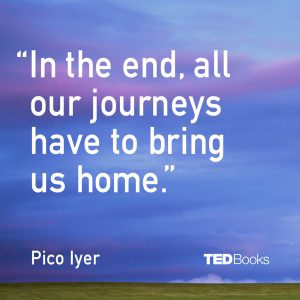 I mentioned this once on a radio program and a woman called in, understandably impatient. “It’s all very well for a male travel writer in Santa Barbara to talk about taking time off,” she said. “But what about me? I’m a mother trying to start a small business, and I don’t have the luxury of meditating for two hours a day.” Yet it’s precisely those who are busiest, I wanted to tell her, who most need to give themselves a break. Stress is contagious, studies have found. If only the poor, overburdened mother could ask her husband — or her mother or a friend — to look after her kids for thirty minutes a day, I’m sure she’d have much more freshness and delight to share with her children when she came back, and with her business.
I mentioned this once on a radio program and a woman called in, understandably impatient. “It’s all very well for a male travel writer in Santa Barbara to talk about taking time off,” she said. “But what about me? I’m a mother trying to start a small business, and I don’t have the luxury of meditating for two hours a day.” Yet it’s precisely those who are busiest, I wanted to tell her, who most need to give themselves a break. Stress is contagious, studies have found. If only the poor, overburdened mother could ask her husband — or her mother or a friend — to look after her kids for thirty minutes a day, I’m sure she’d have much more freshness and delight to share with her children when she came back, and with her business.
Some people, if they can afford it, try to acquire a place in the country or a second home; I’ve always thought it easier to make a second house in the week — especially if, like most of us, you lack the funds for expensive real estate. These days, in the age of movement and connection, space, as Marx had it in another context, has been annihilated by time; we feel as though we can make contact with almost anywhere at any moment. But as fast as geography is coming under our control, the clock is exerting more and more tyranny over us. And the more we can contact others, the more, it sometimes seems, we lose contact with ourselves. When I left New York City for the backstreets of Japan, I figured I’d be growing poorer in terms of money, amusements, social life, and obvious prospects, but I’d be richer in what I prize most: days and hours.
This is what the principle of the Sabbath enshrines. It is, as Abraham Joshua Heschel, the great Jewish theologian of the last century, had it, “a cathedral in time rather than in space”; the one day a week we take off becomes a vast empty space through which we can wander, without agenda, as through the light-filled passageways of Notre Dame. Of course, for a religious person, it’s also very much about community and ritual and refreshing one’s relationship with God and ages past. But even for the rest of us, it’s like a retreat house that ensures we’ll have something bright and purposeful to carry back into the other six days.
The Sabbath recalls to us that, in the end, all our journeys have to bring us home. And we do not have to travel far to get away from our less considered habits. The places that move us most deeply are often the ones we recognize like long-lost friends; we come to them with a piercing sense of familiarity, as if returning to some source we already know. “Some keep the Sabbath going to Church—” Emily Dickinson wrote. “I keep it, staying at Home.”
Pico Iyer’s TED Book, ‘The Art of Stillness: Adventures in Going Nowhere‘ is available now at booksellers worldwide.
Photos by Eydis Einarsdottir.










